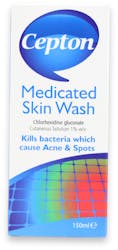Quinoderm Antibacterial Facewash 150ml
Quinoderm Antibacterial Facewash 150ml
What 500,000+ customers say about medino:
Description
Quinoderm Facewash harnesses the power of its antibacterial properties to target spot-prone skin and acne. The dual-action formula works meticulously to remove excess oils, grease, and dirt from the skin's surface, which are known culprits for exacerbating acne. Simultaneously, the facewash nourishes and rejuvenates the skin, promoting a clean and healthy complexion. This combination of deep cleansing and revitalising care ensures that Quinoderm Facewash is an essential ally in the battle against acne and spot-prone skin.
Key features:
- Effectively cleanses spot-prone skin
- Antibacterial: targets acne-causing bacteria
- Penetrates deep into skin layers
- Suitable for acne sufferers
- Contains chlorhexidine digluconate, mytrimonium bromide
- Leaves skin refreshed, clean, and healthy
What are the active ingredients in Quinoderm Antibacterial Facewash?
Quinoderm Facewash contains 0.15% chlorhexidine digluconate and 1.5% mytrimonium bromide. These ingredients work together to provide antibacterial action and effectively cleanse spot-prone skin.
How often should I use Quinoderm Facewash?
For optimal results, use Quinoderm Facewash twice daily, once in the morning and once at night. This routine allows the formula to effectively penetrate the skin and combat excess oil, grease, and bacteria.
Can Quinoderm Facewash be used on sensitive skin?
Quinoderm is designed for spot-prone skin and acne. If you have sensitive skin, it is advisable to consult with a healthcare professional before using the product to ensure it is suitable for your skin type.
Is Quinoderm Facewash safe for use during pregnancy or breastfeeding?
There is no evidence to suggest that using Quinoderm Facewash during pregnancy or breastfeeding causes any issues. However, if you have concerns, consult your doctor for personalised advice.
Usage and Instructions
Always use this medicine exactly as described in this leaflet or as your doctor or pharmacist has told you. Check with your doctor or pharmacist if you are not sure. The recommended dose is: apply two or three times daily. For external use only.
What is the proper application technique for Quinoderm Facewash?
To apply Quinoderm Facewash, first wet your hands and face. Next, massage a generous amount of the product onto your face, focusing on the nose, cheeks, chin, and forehead. Finally, rinse thoroughly to remove all traces of the facewash.
Warnings
Like all medicines, this medicine can cause side effects, although not everybody gets them.
- hypersensitivity (allergic reaction) including local irritation or inflammation
- swollen face
- itch
- rash
- dry skin
- peeling
- redness of skin
It is common for some slight redness of the skin to occur during the early weeks of treatment. This should gradually disappear as your skin becomes accustomed to the treatment. Stop using the medicine and tell your doctor or pharmacist if the original condition worsens.






